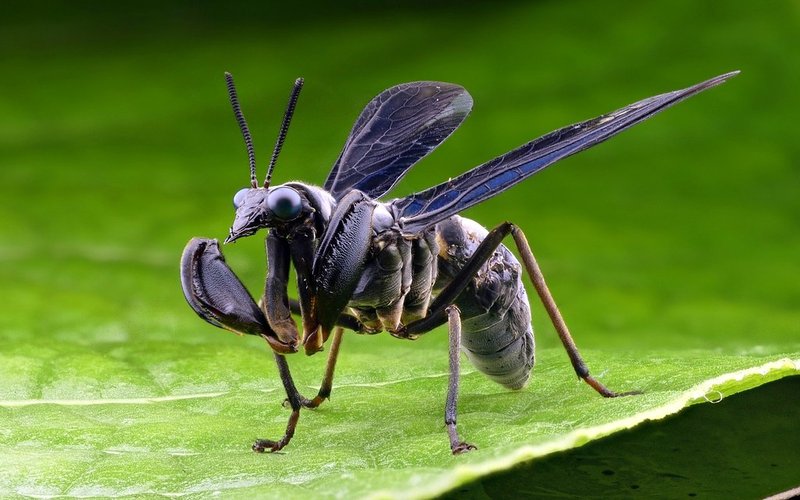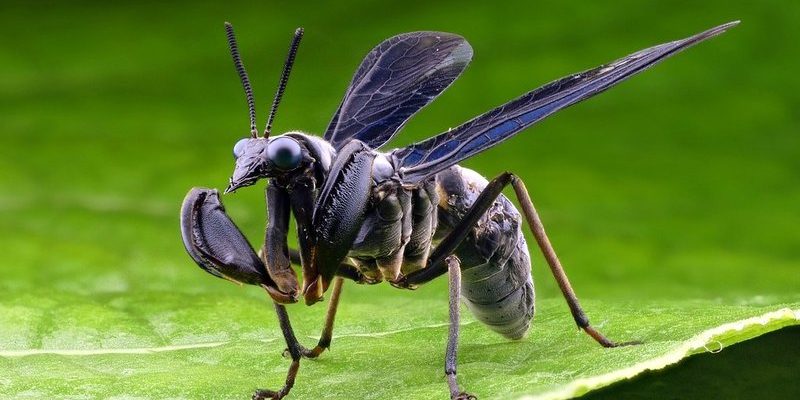
You might be wondering, what on earth is a Mantidfly? At first glance, these creatures might remind you of something between a dragonfly and a praying mantis, and that’s not far off! Mantidflies belong to a unique group of insects that have some striking features. With their elongated bodies and impressive appendages, they carry a certain elegance that captures interest. They are part of the Mantispidae family and are known for their predatory habits, much like their mantis relatives.
Interestingly, the Mantidfly showcases a blend of beauty and deadly precision. As adults, they exhibit captivating colors and patterns that help them blend into their surroundings, making them effective predators. Their life cycle is equally intriguing, revolving around their roles in ecosystems as hunters. Understanding Mantidflies provides a lens into the complex world of insect interactions and highlights how even the smallest creatures can play crucial roles.
So, let’s dig deeper into the lives of Mantidflies, exploring their biology, habitat, behavior, and much more. You might find that these insects are more fascinating than you ever imagined!
Physical Characteristics of Mantidflies
Mantidflies are instantly recognizable due to their unique fusion of traits from two distinct insect families: the mantids and the lacewings. Imagine a lacewing with the hunting prowess of a mantis—that’s a Mantidfly for you! They boast large, raptorial forelegs, which are perfect for catching prey, similar to the hunting technique used by their mantid cousins.
Their bodies can vary significantly in size, typically ranging from 1 to 3 inches in length. This variation often depends on the species and environmental conditions. Their wings are generally long and delicate, showcasing intricate patterns that can range from transparent to brightly colored, depending on the species. Some Mantidflies even sport a striking green coloration, making them blend seamlessly into their leafy habitats.
Additionally, their compound eyes offer a wide field of vision, enhancing their hunting capabilities. This visual prowess is crucial. Mantidflies often hunt other insects, so being able to spot potential meals from a distance is vital. The combination of size, coloration, and specialized features makes Mantidflies fascinating subjects for nature enthusiasts and entomologists alike.
Habitat and Distribution
Mantidflies can be found in various habitats around the world, primarily thriving in warm, temperate, and tropical regions. When you think of their preferred environments, consider places that provide ample foliage and a steady supply of prey—like gardens, forests, and shrubs. They particularly favor areas with plenty of sunlight, as this helps them with thermoregulation and finding mates.
In terms of geographical distribution, Mantidflies have a widespread presence. They can be found on every continent except Antarctica. Their adaptability has allowed them to colonize diverse ecosystems, which is a testament to their resilience as a species. You may encounter them in your backyard, unnoticed, as they typically remain hidden among the foliage, lying in wait for unsuspecting insects.
The diversity within the Mantidfly family is vast. With over 400 species identified, researchers continue to discover new ones, further expanding our understanding of their ecological roles and evolutionary history. This diversity means there’s a lot to learn, whether you’re a casual nature lover or a budding entomologist investigating the web of life around you.
Diet and Hunting Behavior
When it comes to food, Mantidflies are fantastic hunters. Their diet primarily consists of other insects, including flies, moths, and various small arthropods. With their raptorial legs poised and ready, they can swiftly capture prey with precision. This hunting strategy is similar to that of the praying mantis, showcasing the evolutionary connection between these fascinating insects.
The hunting process is not just about speed; it also involves strategy. Mantidflies employ stealth, often waiting motionless for their next meal to come close enough. Once they spot an unsuspecting insect, they spring into action with incredible speed and agility. This ambush technique is not just effective; it often allows them to catch prey much larger than themselves.
Interestingly, their method of consuming prey is equally captivating. Once caught, Mantidflies use their mouthparts to devour their meal, often finishing it quickly to reduce the chances of competition or threat from other predators. This efficiency in hunting and feeding makes them key players in maintaining the balance of ecosystems, highlighting their role as natural pest controllers.
The Life Cycle of a Mantidfly
The life cycle of a Mantidfly is an intricate journey that begins from the egg stage. Females typically lay their eggs in sheltered environments, like leaf litter or plant crevices, ensuring protection from predators. Once the eggs hatch, the larvae emerge and look quite different from their adult counterparts. It’s during this larval stage that they become even more fascinating.
Unlike the adult Mantidflies, the larvae are typically free-living and can often be found lurking in places where other insects congregate. They will feed on small insects, continuing the cycle of predation. This larval form can last several weeks to months, depending on the species and environmental conditions. Here’s the thing: during this stage, they also undergo several molts, shedding their skin to grow larger.
Finally, after reaching maturity, the larvae will pupate. This is where the magic happens! They morph into the adult Mantidfly. The pupation process can be quite delicate and, once completed, the adult emerges, ready to start the cycle all over again. Understanding this life cycle helps us appreciate the fascinating world of Mantidflies and their ecological importance.
Interesting Facts about Mantidflies
| Size: | 1 to 3 inches long |
| Coloration: | Various, often bright and intricate |
| Habitat: | Warm, temperate, and tropical regions |
| Diet: | Other insects, including flies and moths |
| Life Span: | Varies; typically several months |
| Number of Species: | Over 400 identified species |
Conservation Status
Despite their intriguing nature, Mantidflies face various threats in their natural habitats. Habitat loss due to urbanization and agricultural practices poses significant risks. As natural landscapes shrink, the ecosystems that support these fascinating insects become compromised. This loss of habitat not only affects Mantidflies but also the numerous species that share their environment.
Additionally, pesticide use is a pressing concern. While it aims to control pest populations, these chemicals often have unintended consequences, affecting non-target insects, including Mantidflies. Their role as predators means that a decline in their numbers can lead to increased pest populations, creating a ripple effect through the ecosystem.
Conservation efforts are essential to protect Mantidflies and their habitats. Promoting sustainable farming practices, creating green spaces, and raising awareness about the importance of insects in ecosystems can help ensure that Mantidflies continue to thrive. As we learn more about these remarkable creatures, we must advocate for methods that preserve their existence in our world.
Where to Spot Mantidflies
If you’re keen on spotting Mantidflies, the good news is you don’t need to book a ticket to a far-off land. Depending on where you live, these insects can often be found in backyards, gardens, or parks. Look for them during warm months when they are most active. They love sunny spots where they can bask and hunt.
When searching for Mantidflies, take a moment to scan the areas around flowers, shrubs, and even near piles of leaves. Their coloration allows them to blend in quite well, so look closely! You might even spot them during the evening, as some species are crepuscular—active at dusk. Observing them in their natural habitat can be a rewarding experience, providing a window into the lives of these magnificent insects.
Engaging with nature in this way not only deepens our understanding but also fosters a sense of connection with the environment. Every little discovery enriches our appreciation for the biodiversity that surrounds us. So, grab a pair of binoculars and enjoy the thrill of spotting these captivating Mantidflies!
FAQ
What’s the difference between a Mantidfly and a praying mantis?
While Mantidflies and praying mantises share some physical similarities, they belong to different insect families. Mantidflies are more closely related to lacewings, whereas praying mantises belong to their own distinct family. Mantidflies have raptorial front legs like mantises, but their overall body shape and behavior can differ quite a bit, especially in terms of hunting techniques and feeding habits.
Are Mantidflies harmful to humans?
Not at all! Mantidflies pose no threat to humans. Their predatory nature is focused on insects, which means they can actually help control pest populations. They are non-aggressive and will not bite or sting unless provoked. Observing them can be a delightful experience without any fear of harm.
How long do Mantidflies live?
The lifespan of a Mantidfly can vary based on the species and environmental conditions. Generally, they can live for several months, depending on their life cycle stage and available resources. As adults, they tend to have shorter lifespans, often living just long enough to reproduce.
Where can I find Mantidflies in my area?
Mantidflies can often be spotted in gardens, parks, or natural areas with ample vegetation. They thrive in warm environments, so be on the lookout for them during the warmer months. Check places with flowers or dense foliage, as this is where they often hunt for their prey.
What do Mantidflies eat?
Mantidflies are carnivorous and primarily feed on other insects. Their diet includes flies, moths, and various small arthropods. Their predatory behavior makes them significant contributors to the control of pest populations in their environments.
How do Mantidflies catch their prey?
Mantidflies use their raptorial front legs to catch prey. They typically wait motionless and then lunge at their target at incredible speeds. This ambush strategy allows them to capture insects much larger than themselves, showcasing their impressive hunting skills.
Can Mantidflies be found in colder regions?
While Mantidflies prefer warmer climates, some species can adapt to cooler environments. However, their presence may be less common in regions with harsh winters. They typically thrive in temperate and tropical areas, where they can find suitable habitats for breeding and hunting.
How many species of Mantidflies are there?
There are over 400 identified species of Mantidflies worldwide! This diversity highlights their adaptability and the various ecological niches they occupy. Each species exhibits unique characteristics, making them a fascinating subject of study for entomologists and nature enthusiasts alike.
Are Mantidflies solitary or social insects?
Mantidflies are generally solitary insects, primarily focused on hunting and reproduction. While they may share a habitat with others, they do not form social groups like some other insects. Their solitary nature allows them to be efficient hunters, reducing competition for food.
Do Mantidflies have any natural predators?
Yes, Mantidflies do have natural predators. Birds, larger insects, and even some mammals may prey on them. Their ability to camouflage helps them evade these threats, but they remain vulnerable, especially during their larval stages.
How can I help conserve Mantidflies?
You can help conserve Mantidflies by creating a welcoming environment for them in your garden. Plant native flowers and reduce pesticide use, which can harm beneficial insects. Supporting conservation efforts and raising awareness about the importance of insects can also contribute to maintaining healthy ecosystems where Mantidflies can thrive.

